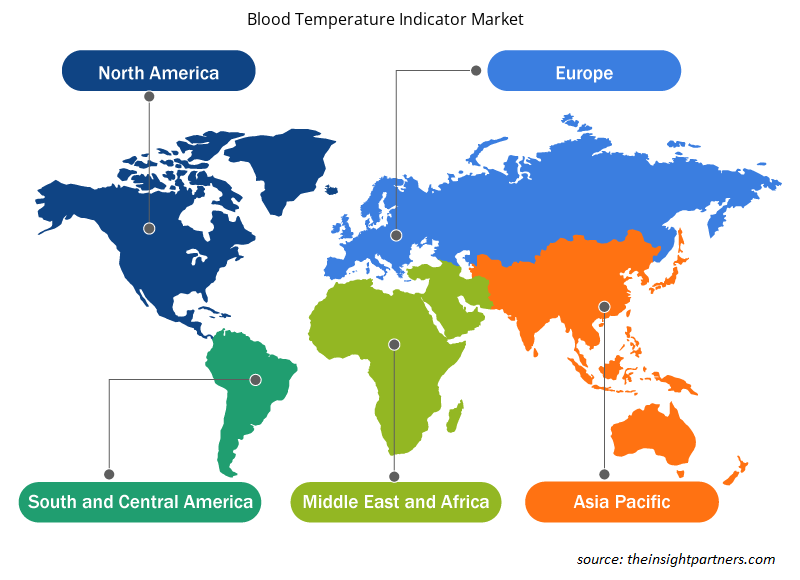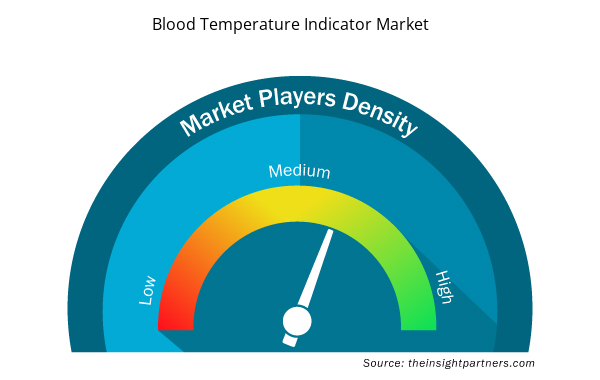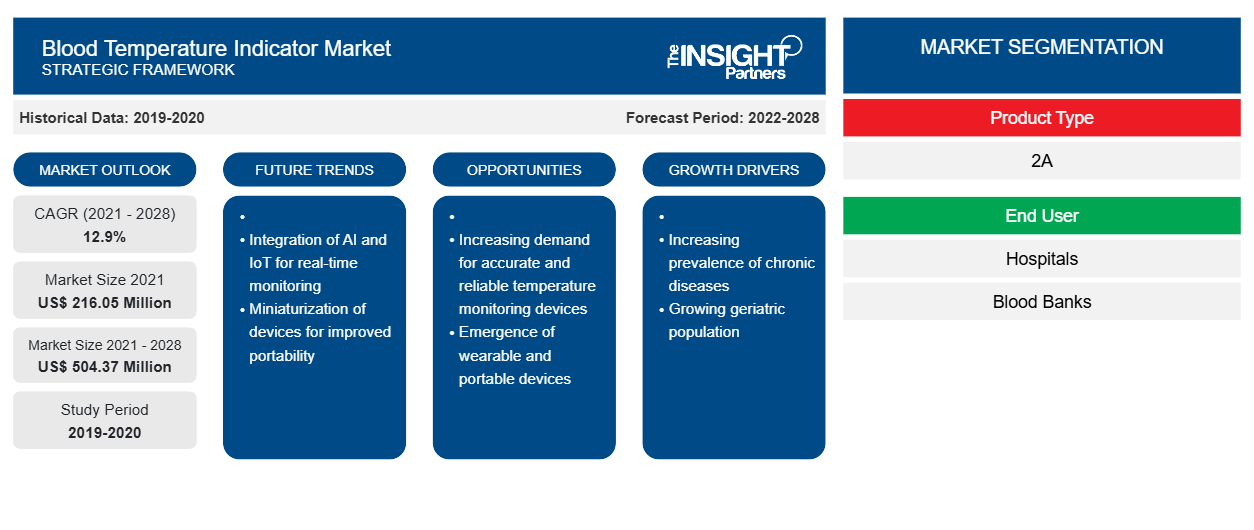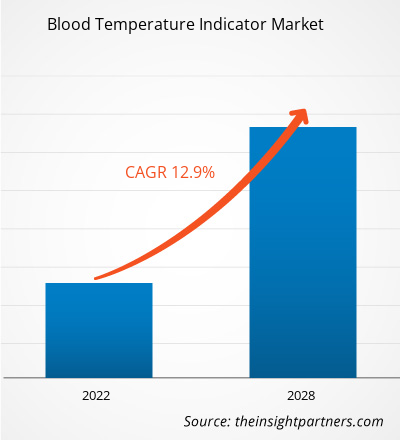Se espera que el mercado de indicadores de temperatura sanguínea crezca de US$ 216,05 millones en 2021 a US$ 504,37 millones en 2028; se estima que registrará una CAGR del 12,9% entre 2021 y 2028.
Los indicadores de temperatura sanguínea son pequeños dispositivos o soluciones médicas que ayudan a aumentar la seguridad de la sangre mediante el transporte eficaz y eficiente de la sangre y sus componentes. Estos indicadores proporcionan una prueba auditable de que la sangre se almacena y transporta de acuerdo con las normas reglamentarias, lo que reduce aún más el desperdicio de sangre.
El informe proporciona información y un análisis en profundidad del mercado de indicadores de temperatura sanguínea , haciendo hincapié en varios parámetros como las tendencias del mercado, los avances tecnológicos y la dinámica del mercado. También proporciona el análisis del panorama competitivo de los principales actores del mercado y el impacto de la pandemia de COVID-19 en el mercado de indicadores de temperatura sanguínea en todas las regiones principales. La pandemia de COVID-19 ha alterado las condiciones socioeconómicas de varios países del mundo. Según las estadísticas de la OMS de 2021, Estados Unidos es el país más afectado del mundo debido a la pandemia de COVID-19, con el mayor número de casos de COVID-19. El elevado número de casos ha obstaculizado la economía de América del Norte, especialmente de Estados Unidos. La pandemia de COVID-19 ha provocado cambios tecnológicos críticos para proporcionar una mejor atención médica. Debido a la propagación del SARS-CoV-2, muchas ciudades están cerradas, lo que ha provocado cancelaciones de tratamientos por parte de médicos/cirujanos. La pandemia de COVID-19 ha afectado a la fabricación y el suministro de indicadores de temperatura sanguínea debido a la interrupción de la cadena de suministro a nivel mundial. Además, los profesionales de la salud están priorizando los procedimientos de emergencia y cancelaron todas las cirugías electivas para prevenir la propagación del coronavirus.
En 2020, la Administración de Alimentos y Medicamentos (FDA) autorizó el uso de emergencia de plasma convaleciente para el tratamiento de pacientes con COVID-19, lo que provocó un aumento en la donación de sangre. Además, se espera que la presencia de importantes actores del mercado y sus diversas colaboraciones estratégicas en el mercado de indicadores de temperatura sanguínea respalden el crecimiento del mercado. Por ejemplo, Timestrip, el desarrollador de tecnología de indicadores inteligentes, está lanzando una gama completamente nueva con dos indicadores electrónicos de temperatura. Estos indicadores serán fundamentales para monitorear el almacenamiento y transporte seguros de varios productos, incluidos productos farmacéuticos, vacunas, atención médica, productos alimenticios, adhesivos y tintas. Por lo tanto, la pandemia de COVID-19 afectó negativamente al mercado de indicadores de temperatura sanguínea.
Según la región, el mercado de indicadores de temperatura sanguínea está segmentado en América del Norte, Europa, Asia Pacífico, Medio Oriente y África, y América del Sur y Central.
Personalice este informe según sus necesidades
Obtendrá personalización en cualquier informe, sin cargo, incluidas partes de este informe o análisis a nivel de país, paquete de datos de Excel, así como también grandes ofertas y descuentos para empresas emergentes y universidades.
- Obtenga las principales tendencias clave del mercado de este informe.Esta muestra GRATUITA incluirá análisis de datos, desde tendencias del mercado hasta estimaciones y pronósticos.
Perspectivas del mercado
El aumento de las transfusiones y donaciones de sangre impulsa el mercado de indicadores de temperatura sanguínea
La transfusión de sangre es uno de los procedimientos más utilizados en el ámbito sanitario, que ayuda a mantener el nivel de sangre de los pacientes. Existen diversas enfermedades crónicas, procedimientos quirúrgicos y casos de traumatismos que requieren una transfusión de sangre para que los pacientes puedan sobrevivir sin efectos secundarios debido a los bajos niveles de sangre. Las afecciones médicas, como la talasemia, el cáncer de sangre , la anemia de células falciformes, la anemia y los casos quirúrgicos y traumáticos, provocan pérdida de sangre y requieren una transfusión de sangre. Según la organización de la Cruz Roja Estadounidense, cada año se transfunden unos 16 millones de componentes sanguíneos en los EE. UU. Además, la anemia de células falciformes afecta a entre 90 000 y 100 000 personas en los EE. UU.; unos 1000 bebés nacen con esta enfermedad cada año. Por lo tanto, la creciente prevalencia de enfermedades crónicas ha creado la demanda de transfusiones de sangre, lo que se espera que impulse el crecimiento del mercado de indicadores de temperatura sanguínea.
Después de la extracción, la sangre debe almacenarse y transportarse en condiciones y temperaturas específicas. Si la sangre se almacena y transporta fuera del rango de temperatura específico durante un tiempo prolongado, pierde su capacidad de transportar oxígeno, lo que puede causar problemas graves. Además, existe el riesgo de una contaminación bacteriana grave si la sangre se expone a temperaturas cálidas. Los indicadores de temperatura de la sangre desempeñan un papel importante en el mantenimiento de las condiciones y la temperatura requeridas para el transporte seguro y confiable de la sangre y sus componentes. Reduce las posibilidades de deterioro de la sangre al controlar de cerca la temperatura y mantener la sangre segura durante el transporte. Por lo tanto, el aumento de las transfusiones de sangre, la donación de sangre y la creciente demanda de transporte seguro de sangre y sus componentes crea una demanda de indicadores de temperatura de la sangre, lo que impulsa el crecimiento del mercado.
Información basada en el tipo de producto
Según el tipo de producto, el mercado de indicadores de temperatura sanguínea se segmenta en 2 °C a 4 °C, 5 °C a 7 °C y más de 7 °C. En 2021, el segmento de 2 °C a 4 °C representó la mayor participación de mercado. La posición de mercado de este segmento ha aumentado debido a su principal uso durante el transporte de sangre en rutas largas. Por ejemplo, según las principales pautas europeas y estadounidenses, la temperatura de las bolsas de glóbulos rojos debe oscilar entre 1 °C y 6 °C durante el almacenamiento y entre 1 °C y 10 °C durante el transporte.
Perspectivas regionales del mercado de indicadores de temperatura sanguínea
Los analistas de Insight Partners explicaron en detalle las tendencias y los factores regionales que influyen en el mercado de indicadores de temperatura sanguínea durante el período de pronóstico. Esta sección también analiza los segmentos y la geografía del mercado de indicadores de temperatura sanguínea en América del Norte, Europa, Asia Pacífico, Oriente Medio y África, y América del Sur y Central.

- Obtenga datos regionales específicos para el mercado de indicadores de temperatura sanguínea
Alcance del informe de mercado de indicadores de temperatura sanguínea
| Atributo del informe | Detalles |
|---|---|
| Tamaño del mercado en 2021 | US$ 216,05 millones |
| Tamaño del mercado en 2028 | US$ 504,37 millones |
| CAGR global (2021-2028) | 12,9% |
| Datos históricos | 2019-2020 |
| Período de pronóstico | 2022-2028 |
| Segmentos cubiertos | Por tipo de producto
|
| Regiones y países cubiertos | América del norte
|
| Líderes del mercado y perfiles de empresas clave |
|
Densidad de actores del mercado de indicadores de temperatura sanguínea: comprensión de su impacto en la dinámica empresarial
El mercado de indicadores de temperatura sanguínea está creciendo rápidamente, impulsado por la creciente demanda de los usuarios finales debido a factores como la evolución de las preferencias de los consumidores, los avances tecnológicos y una mayor conciencia de los beneficios del producto. A medida que aumenta la demanda, las empresas amplían sus ofertas, innovan para satisfacer las necesidades de los consumidores y aprovechan las tendencias emergentes, lo que impulsa aún más el crecimiento del mercado.
La densidad de actores del mercado se refiere a la distribución de las empresas o firmas que operan dentro de un mercado o industria en particular. Indica cuántos competidores (actores del mercado) están presentes en un espacio de mercado determinado en relación con su tamaño o valor total de mercado.
Las principales empresas que operan en el mercado de indicadores de temperatura sanguínea son:
- Élitech
- Termo Fisher Scientific Inc.
- Sercalia
- Grupo Ellab
- Corporación Zebra Technologies
Descargo de responsabilidad : Las empresas enumeradas anteriormente no están clasificadas en ningún orden particular.

- Obtenga una descripción general de los principales actores clave del mercado de indicadores de temperatura sanguínea
Información para el usuario final
Según el usuario final, el mercado de indicadores de temperatura sanguínea se segmenta en hospitales, bancos de sangre y otros. El segmento de hospitales dominó el mercado en 2021.
Los actores del mercado de indicadores de temperatura sanguínea adoptan estrategias orgánicas como el lanzamiento y la expansión de productos para expandir su presencia y cartera de productos a nivel mundial.
Perfiles de empresas
- Élitech
- Producto de Thero Fisher Scientific Inc.
- Sercalia
- Grupo Ellab
- Corporación Zebra Technologies
- Tecnologías de Lisaline Lifesciences
- Stream Peak International PTE Ltd
- 3M
- DeltaTrak Inc.
- TimeStrip Reino Unido Ltd.
- Análisis histórico (2 años), año base, pronóstico (7 años) con CAGR
- Análisis PEST y FODA
- Tamaño del mercado Valor/volumen: global, regional, nacional
- Industria y panorama competitivo
- Conjunto de datos de Excel


- Grant Management Software Market
- Visualization and 3D Rendering Software Market
- Fish Protein Hydrolysate Market
- Non-Emergency Medical Transportation Market
- Electronic Shelf Label Market
- Europe Surety Market
- Photo Editing Software Market
- Parking Management Market
- Airport Runway FOD Detection Systems Market
- Bathroom Vanities Market

Report Coverage
Revenue forecast, Company Analysis, Industry landscape, Growth factors, and Trends

Segment Covered
This text is related
to segments covered.

Regional Scope
North America, Europe, Asia Pacific, Middle East & Africa, South & Central America

Country Scope
This text is related
to country scope.
Preguntas frecuentes
Global blood temperature indicator market is segmented by region into North America, Europe, Asia Pacific, Middle East & Africa, and South & Central America. In North America, the U.S. is the largest market for blood temperature indicator market. The US is estimated to hold the largest share in the blood temperature indicator market during the forecast period. The presence of top players and increased demand for blood transfusion are the contributing factors for the regional growth. Additionally, improvements in healthcare infrastructure, increase in blood banks, high adoption rate and increased awareness among people regarding blood donation are the key factor responsible for the Asia-Pacific regional growth for blood temperature indicator accounting fastest growth of the region during the coming years.
Elitech; Thermo Fisher Scientific Inc.; Ellab Group; Zebra Technologies Corporation; LisaLine Lifesciences Technologies; Stream Peak International Pte Ltd.; 3M; TimeStrip UK Ltd. are among the leading companies operating in the global blood temperature indicator market
The hospital segment dominated the global blood temperature indicator market and accounted for the largest revenue of US$ 90.35 Mn in 2021.
Blood Temperature Indicators are small medical devices or solutions which helps in increasing the blood safety and allows effective and efficient transportation of blood and its components. These indicators provide auditable proof that blood is stored and transported as per regulatory standards this further reduces blood waste.
Increase in blood transportation and donation owing to increasing awareness and rising prevalence of various conditions such as chronic disorders, surgeries trauma cases along with accuracy of blood temperature indicator are the most significant factors responsible for the overall market growth.
Based on product type, 2°C to 4°C segment took the forefront lead in the worldwide market by accounting largest share in 2021 and is expected to continue to do so till the forecast period.
Trends and growth analysis reports related to Life Sciences : READ MORE..
The List of Companies - Blood Temperature Indicator Market
- Elitech
- Thermo Fisher Scientific Inc.
- Sercalia
- Ellab Group
- Zebra Technologies Corporation
- Lisaline Lifesciences Technologies
- Stream Peak International PTE Ltd
- 3M
- DeltaTrak Inc
- TimeStrip UK Ltd
The Insight Partners performs research in 4 major stages: Data Collection & Secondary Research, Primary Research, Data Analysis and Data Triangulation & Final Review.
- Data Collection and Secondary Research:
As a market research and consulting firm operating from a decade, we have published and advised several client across the globe. First step for any study will start with an assessment of currently available data and insights from existing reports. Further, historical and current market information is collected from Investor Presentations, Annual Reports, SEC Filings, etc., and other information related to company’s performance and market positioning are gathered from Paid Databases (Factiva, Hoovers, and Reuters) and various other publications available in public domain.
Several associations trade associates, technical forums, institutes, societies and organization are accessed to gain technical as well as market related insights through their publications such as research papers, blogs and press releases related to the studies are referred to get cues about the market. Further, white papers, journals, magazines, and other news articles published in last 3 years are scrutinized and analyzed to understand the current market trends.
- Primary Research:
The primarily interview analysis comprise of data obtained from industry participants interview and answers to survey questions gathered by in-house primary team.
For primary research, interviews are conducted with industry experts/CEOs/Marketing Managers/VPs/Subject Matter Experts from both demand and supply side to get a 360-degree view of the market. The primary team conducts several interviews based on the complexity of the markets to understand the various market trends and dynamics which makes research more credible and precise.
A typical research interview fulfils the following functions:
- Provides first-hand information on the market size, market trends, growth trends, competitive landscape, and outlook
- Validates and strengthens in-house secondary research findings
- Develops the analysis team’s expertise and market understanding
Primary research involves email interactions and telephone interviews for each market, category, segment, and sub-segment across geographies. The participants who typically take part in such a process include, but are not limited to:
- Industry participants: VPs, business development managers, market intelligence managers and national sales managers
- Outside experts: Valuation experts, research analysts and key opinion leaders specializing in the electronics and semiconductor industry.
Below is the breakup of our primary respondents by company, designation, and region:

Once we receive the confirmation from primary research sources or primary respondents, we finalize the base year market estimation and forecast the data as per the macroeconomic and microeconomic factors assessed during data collection.
- Data Analysis:
Once data is validated through both secondary as well as primary respondents, we finalize the market estimations by hypothesis formulation and factor analysis at regional and country level.
- Macro-Economic Factor Analysis:
We analyse macroeconomic indicators such the gross domestic product (GDP), increase in the demand for goods and services across industries, technological advancement, regional economic growth, governmental policies, the influence of COVID-19, PEST analysis, and other aspects. This analysis aids in setting benchmarks for various nations/regions and approximating market splits. Additionally, the general trend of the aforementioned components aid in determining the market's development possibilities.
- Country Level Data:
Various factors that are especially aligned to the country are taken into account to determine the market size for a certain area and country, including the presence of vendors, such as headquarters and offices, the country's GDP, demand patterns, and industry growth. To comprehend the market dynamics for the nation, a number of growth variables, inhibitors, application areas, and current market trends are researched. The aforementioned elements aid in determining the country's overall market's growth potential.
- Company Profile:
The “Table of Contents” is formulated by listing and analyzing more than 25 - 30 companies operating in the market ecosystem across geographies. However, we profile only 10 companies as a standard practice in our syndicate reports. These 10 companies comprise leading, emerging, and regional players. Nonetheless, our analysis is not restricted to the 10 listed companies, we also analyze other companies present in the market to develop a holistic view and understand the prevailing trends. The “Company Profiles” section in the report covers key facts, business description, products & services, financial information, SWOT analysis, and key developments. The financial information presented is extracted from the annual reports and official documents of the publicly listed companies. Upon collecting the information for the sections of respective companies, we verify them via various primary sources and then compile the data in respective company profiles. The company level information helps us in deriving the base number as well as in forecasting the market size.
- Developing Base Number:
Aggregation of sales statistics (2020-2022) and macro-economic factor, and other secondary and primary research insights are utilized to arrive at base number and related market shares for 2022. The data gaps are identified in this step and relevant market data is analyzed, collected from paid primary interviews or databases. On finalizing the base year market size, forecasts are developed on the basis of macro-economic, industry and market growth factors and company level analysis.
- Data Triangulation and Final Review:
The market findings and base year market size calculations are validated from supply as well as demand side. Demand side validations are based on macro-economic factor analysis and benchmarks for respective regions and countries. In case of supply side validations, revenues of major companies are estimated (in case not available) based on industry benchmark, approximate number of employees, product portfolio, and primary interviews revenues are gathered. Further revenue from target product/service segment is assessed to avoid overshooting of market statistics. In case of heavy deviations between supply and demand side values, all thes steps are repeated to achieve synchronization.
We follow an iterative model, wherein we share our research findings with Subject Matter Experts (SME’s) and Key Opinion Leaders (KOLs) until consensus view of the market is not formulated – this model negates any drastic deviation in the opinions of experts. Only validated and universally acceptable research findings are quoted in our reports.
We have important check points that we use to validate our research findings – which we call – data triangulation, where we validate the information, we generate from secondary sources with primary interviews and then we re-validate with our internal data bases and Subject matter experts. This comprehensive model enables us to deliver high quality, reliable data in shortest possible time.


 Obtenga una muestra gratuita de este informe
Obtenga una muestra gratuita de este informe